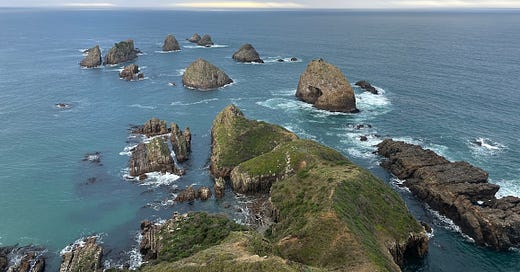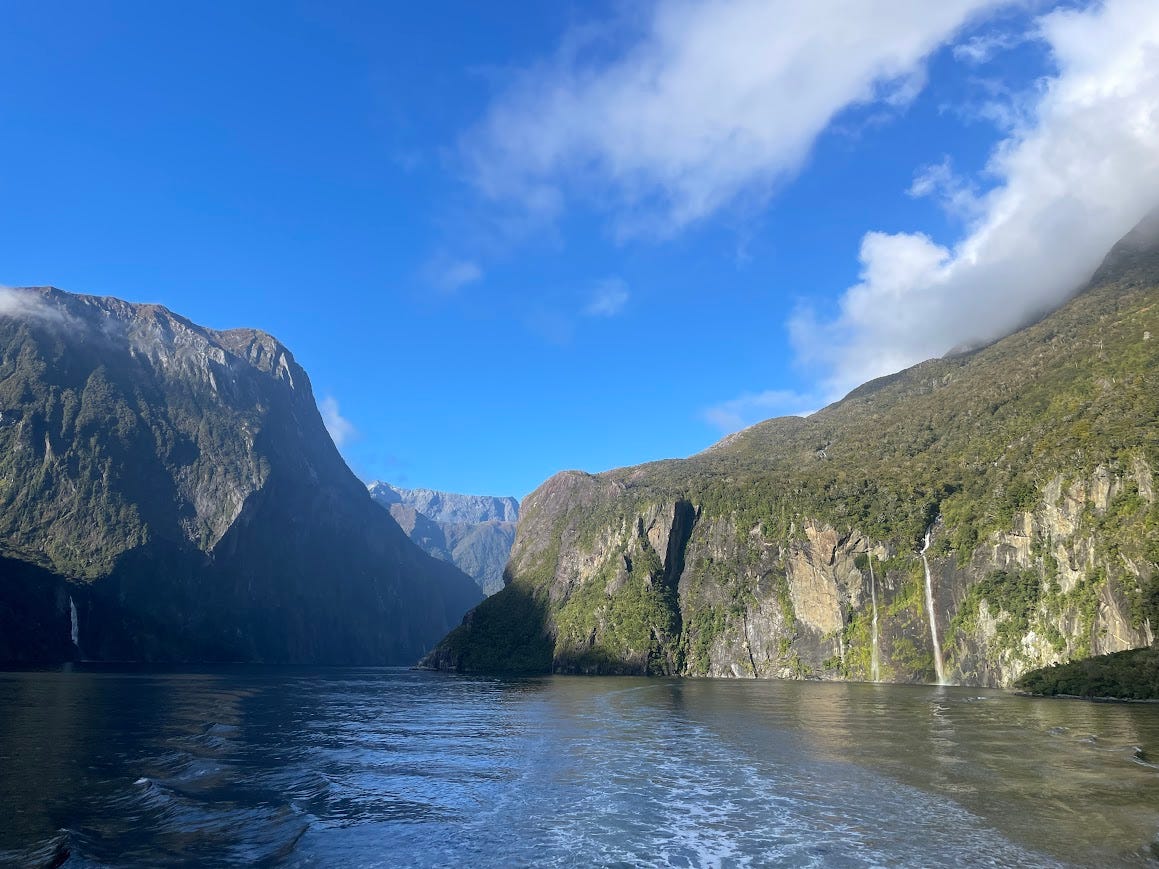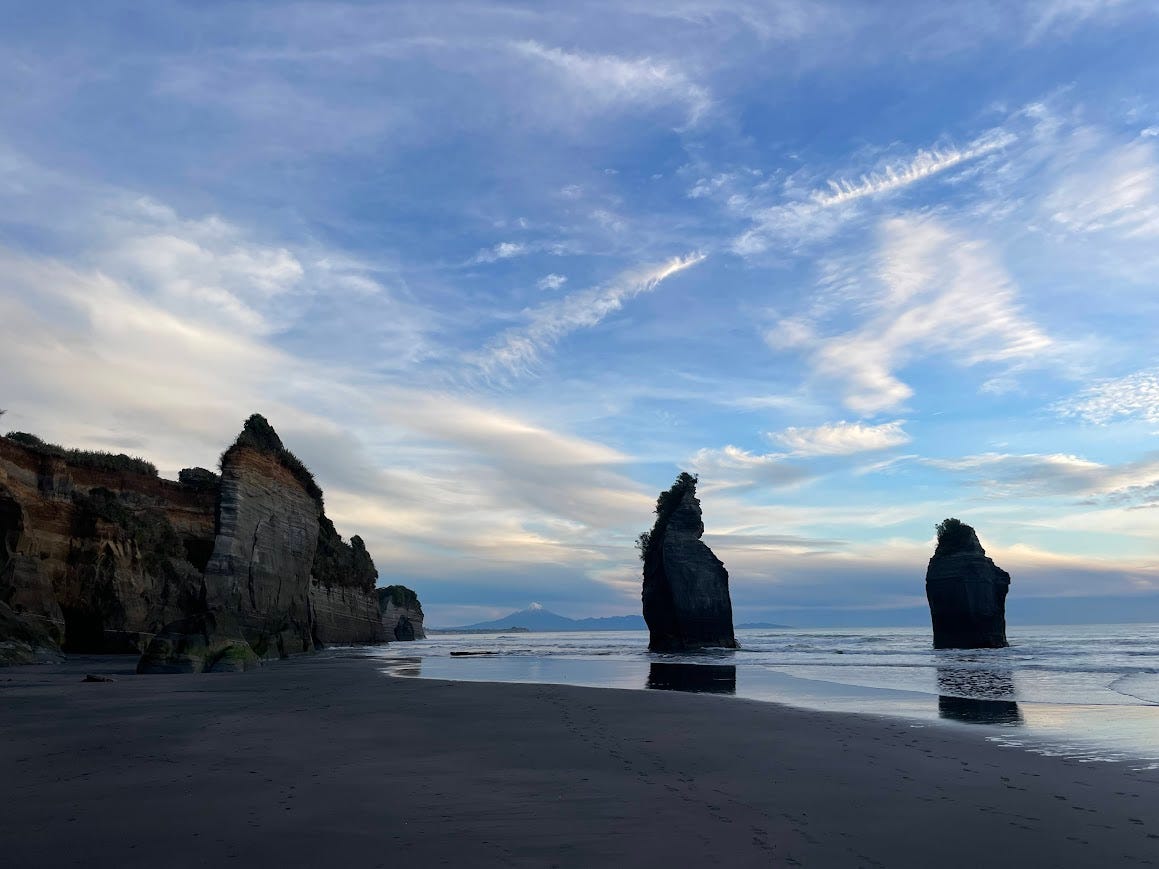Hi from the top of the North Island, about as far as you can get in New Zealand from our location when I last posted! We had spent Chris’s birthday (NZT) traveling through the Catlins with our friend. We saw the rare hoiho/yellow-eyed penguin, the southernmost point of the South Island, and a submerged petrified forest! On Chris’s birthday (EST, you get both days if your birthday crosses time zones!), we finally made it to Milford Sound! One of the most famous destinations in the world for its natural beauty, it was on our must-do list before leaving the South Island.

As a reminder, our primary reason for leaving the South Island is that it’s winter here! Being in the Southern Hemisphere also means that, unlike back home, it’s colder down south. Our first night below freezing in the van was actually fairly manageable, thanks to the truly life-changing existence of hot water bottles. I could have avoided so many nights shivering myself to sleep in my terribly insulated apartments if these amazing, simple fixtures hadn’t fallen out of common use in the U.S. Our British and Kiwi friends laughed when we tried to explain our new discovery to them (“it’s like a hot bottle of water, but not one you drink out of”), as hot water bottles are essentially ubiquitous in every household in both countries. I thought maybe we were just out of touch, but a quick Internet search revealed countless discussion threads of British expats in the U.S. being shocked to not find them! This is a recommendation to do yourself a favor and get a hot water bottle! But I digress.
On the morning of our trip to Milford Sound, we had woken up to a bit of a fiasco. Our van doors wouldn’t open! Which is a problem when you are sleeping inside and trying to get out to pee. We tried to open the doors several times before Chris finally jumped over our belongings in the front seat to escape. But because our shoes were stored behind the stuck doors, he jumped onto the frosty grass in just his socks. Brr! After trying to wrestle the door open, he finally gave up in desperation to use the bathroom. I continued to try to get the doors to open from the inside, setting off an alarm in the process. As one does, I started Googling the problem, only to be inundated with suggestions of serious, costly electrical problems and truly spell-like instructions on how to fix it (e.g., open and shut driver door manually five times while pressing the lock and unlock button simulaneously — we may as well have repeated “MPV, MPV, please open your doors for me” and spun around). By the time Chris came back, I was on all fours, looking like a feral cat trapped in a box with my hair stuck to the ceiling by the tacks that hang our lights, eyes crazed from listening to the ringing noises. Chris’s feet were going numb, and he still didn’t have access to his shoes! Needless to say, it was chaotic. Eventually, we realized the electrical wasn’t working due to the frost, found the button that resets the power, and managed to wedge them open.
But our trials were not over, because we had another important car issue to fix that morning: a $400 NZD ($250 USD) fine that we had been issued by the poop police! A few days prior, we had stayed at a free campground in the Catlins. This was our first experience encountering that certain districts in New Zealand don’t abide by the national self-containment laws. New Zealand is making changes on a national level in June 2025, which will mean a lot of campervans need to be converted to meet the updated standards. Which is complicated! On one hand, it’s understandable that districts want to ensure people are respectful of public space and not (ab)using nature as a giant toilet. On the other hand, some people view it as part of the classist assumptions about and backlash against freedom campers.
Not able to see a fixed toilet in our van, the ranger issued us the fine (my favorite part was how he crossed out the $200 printed on the ticket and wrote $400 in pen). Ironically, he did this while we were using the paid facilities for showers and bathrooms! We were really frustrated that we had done everything to follow the rules, and had still been hit with this fine. Unfortunately for my anxious brain, we also had to wait until the weekend was over to call about appealing it. Flash forward to us taking photos of me hunching on our portable toilet to prove that, technically, it can be used with the bed intact in case of an emergency. Because Chris is charming and kind, the fine was eventually dropped.
But enough of the potty talk! While these stories are funny in retrospect, I can say for myself that I had reached a point of moderate stress living in the van. When this happened, there had not been a single day in over a month where we were not actively solving a car issue or waiting to be able to do so. Aware that we kind of blew it with our first van, we have been trying to be more responsible and knowledgeable van owners. We did some proactive maintenance on the van that was identified in our pre-purchase inspection, and we have been checking the oil almost every day (*growth*). We are, for better or worse, quite paranoid now! Every time the car makes a weird noise, we start making a contingency plan based on how close we are to a mechanic and a cheap motel. By the time we were hit with the fine and failure of our van doors, I could not be bothered to deal with any more van problems. As we continued to manage little issues with long hours of driving, it put me into a reflective headspace about the challenges that come with the lifestyles we choose.
The Things We Choose
If I were to remember only one concept from my sociology degree, it would be the tension between structure and agency. What things do we choose, and what things are decided for us, directly or indirectly, via the structures that determine the set of options available to us? As our society confronts legacies of discrimination, more people and institutions are acknowledging that predictable disparities in life outcomes are a result of structural factors, and are moving away from abusing ideas of individual agency to blame people for poor outcomes. Identifying and providing evidence for these structural factors was a core part of my previous job! And yet, being a hard-core structuralist can be depressing and dehumanizing. It’s not right to view people or groups simply as victims or beneficiaries or to treat their experiences as inevitable. Yes, we can advocate to change structures, but in the meantime, people are living full, complex lives that should be seen as such. For this reason, most good theorists and practitioners see agency and structure as complementary.
At times, I have tended to view my own life through a structural lens in ways that are detrimental to my mental health. As I’ve written about extensively in this newsletter, the factors that led me to making a big lifestyle change felt deeply personal, but few of them were unique to me. I understood that American office culture, the lack of convenient transportation and housing options, and the decline of community ties were all structural factors that negatively impacted my daily life and wellbeing. I lived in a city that is visibly struggling (and to a large degree unwilling) to address the root causes of suffering among its most vulnerable populations. This further contributed to the feeling that, when it comes to building the world we want, so much is out of our control. I was involved in efforts, big and small, to change these things. And yet, structures do not often change or improve quickly. I felt a sense of hopelessness, both for my own ability to build the life that I wanted for myself, and for larger-scale changes that would create a more just world.
I felt responsible for choosing my circumstances (so therefore unable to complain), but also that my circumstances were a result of forces bigger than myself and were therefore unlikely to change dramatically. While I may have chosen to move to Denver, I was also just one person in a migration of people my age moving from expensive, career-driven cities to (allegedly) cheaper, more life-style driven places.1 While I may have, on one level, chosen my job, a structuralist might say that the process that led me into this particular role was one that began a long time ago: in the gendered ways girls are encouraged into social sciences over hard sciences, in the racialized tracking system for gifted programs that benefited me from elementary school through college, in the decision that roles like mine would only be available to college graduates rather than to people trained on the job, in the cultural messages I’ve received about seeking out meaning-driven careers, and in the social influences from my family and community about which issues to care about.
I felt stuck. Changing to a less meaning-driven career felt like a compromise of my values. Changing to a career “below” my level of educational attainment challenged expectations of me and felt financially risky. Changing to another, similar job and hoping it would solve my problems felt misguided. Trying to move to another city when the factors that made me unhappy are common across American cities felt like starting all over for no good reason. Again, I couldn’t honestly look at my life and say I hadn’t made these choices. But I also felt hyperaware of the factors that had led me to this specific set of decisions, and unsure how to make meaningfully different changes.
Which brings us to this recess year. I guess if you’re a hard-core structuralist, you might say that the decision to move to New Zealand was determined by the social, economic, and political factors contributing to my disillusionment and burnout. A travel sabbatical is a socially acceptable and logistically feasible off-ramp for people in my socioeconomic position. While I tend to lean more towards structural explanations myself, moving to New Zealand and leading this particular lifestyle was undeniably a choice. I didn’t just trip and fall from a stable government job into living in a van on the other side of the world.
Sometimes when you’re so far down a certain path, it can begin to feel like you don’t have agency. Over your time, your lifestyle, your relationship to work. Maybe this path was once a choice, but the sunk cost of the steps already taken thus far make it feel like it no longer is a choice. Individual agency is always going to be constrained — by structures, and sometimes by our own previous choices. But I have found that it is an essential coping mechanism to be able to identify and remind yourself of the areas in your life where you do have agency, where you can change the things that aren’t working for you, where you can exert influence, individually or collectively.
As I’ve written about, there are so many reasons making this change has been good for me. But even if I removed any of the specifics of where we are and how we spend our days, I think the change has been good simply because it is a choice in which I felt, and continue to feel, agency. On the days that are difficult, I remind myself that being here is a choice. And that to have these challenges – of managing life in a van that is almost as old as me – are ones I chose to have over other challenges I might have faced on a different path. While there are always going to be things that I didn’t choose, I want to remember and acknowledge the things that I did choose. That the challenges I’m having related to those choices are because of something else worth having or striving toward. That I have the ability to decide whether to continue to accept each set of circumstances, with its specific joys and challenges, or to choose other ones. Within the world we live in now, however many ways I might wish and advocate for it to be different, I have the agency to build a life that I like, that I want, that I’m proud of.
Checkpoints!
After Milford Sound, we made our way gradually but efficiently back to the top of the South. For the first time, we were passing through a lot of places we had been before, so we indulged ourselves in some favorites (Fergburger in Queenstown, and an Indian takeaway spot called Be Foodie that punches above its weight in the small town of Geraldine). We also briefly visited all of our former WWOOFing hosts (well, excluding the ones who tried to make us their unpaid housekeeping staff). It was really lovely to catch up and reflect on how much we have done in five months! In a time where almost everywhere we go is new to us, it was nice to return to places on the map we had already unlocked, so to speak, especially as we go into the halfway-mark for our year here.
I’d be remiss not to add that we also spent a few days in Taranaki, which we can’t believe doesn’t even make the big lists for a top destination in New Zealand. Between biking the coastal trail, seeing views of the volcano from every angle, and visiting gorgeous public parks, we were absolutely charmed.
Now we’ve made it to the Far North, where we are staying in an off-grid cabin for the week – I literally wrote this by candlelight – volunteering on a wetland restoration project. More to come on this soon!
This is a common narrative, and one that I could certainly feel as a young transplant meeting countless other young people who had moved to Denver within the same few-year span. But it is only sort of supported by data! As I mentioned in my newsletter about apartment hunting in Denver, there’s a lot of conflicting articles on this topic. CityLab (now Bloomberg) argues there was more of a shuffle than a mass exodus from major cities during the early stages of the pandemic.






